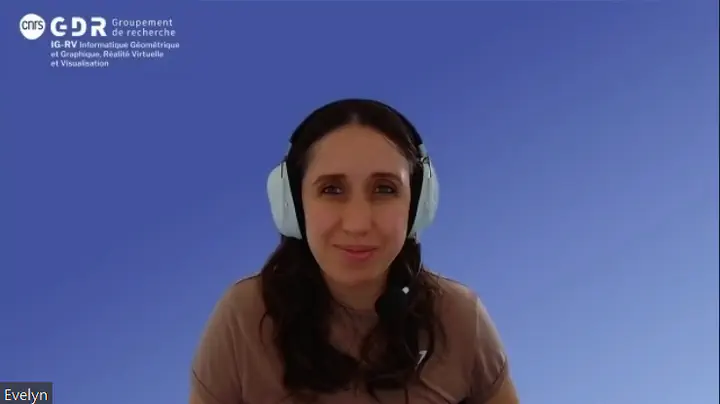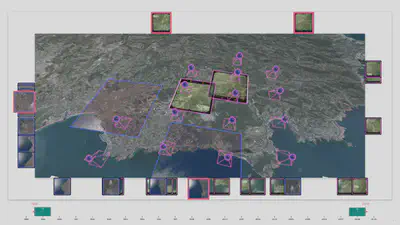Evelyn Paiz - Visual exploration of historical image collections: an interactive approach through space and time

What is your current research status?
Last year, I finished my PhD at IGN, and defended it in December 2021. I’m currently a research and development engineer at Viceversa, a company that aims at transferring object from the real world to the metaverse. For example, a company could own this object and visualize it online. This can also be used for gaming applications.
Can you describe your research work during your PhD?
It was how to visualize digitally historical images. My lab was acquiring a lot of pictures and gather them from other institutions. The objective of the PhD was to present a method for people to visualize these pictures digitally, in 3D, and to explore these pictures in time and space. There were two topics. The first was the rendering of these images: how to render these 2D images in 3D? This includes the issue of the distortion of the pictures during acquisition and how to manage this distortion while projecting the image in a 3D space. We came up with a method to extrapolate the distortion function of these images to be able to correct them during the projection. The second topic was more about how user can interact with the pictures in the 3D space. We presented to the users different methods to be able to interact with the pictures.

We had different types of data: 2D images but also 3D models, a bit like Google Maps where you can have those two kinds of visualization. IGN has this kind of data for France, and we were using these 3D data and project our “old” pictures on the model to be able to fill the voids of the images. I was focusing on the distortion part, for the user to have a rectangular image. When you do a projection of a 3D model, you must consider the distortion, otherwise you will have a distortion between the 3D world and the 2D image. If you consider it, your image will be distorted, and you have to correct its shape.
The second part of the PhD was more tackling how the user can interact with these images when they are in 3D. I was exploring methods like heatmaps, viewpoint markers, adding frames or color values to the images for user to be able to quickly find images among many in 3D.

We presented the images to the user on a screen, to be able to explore the web option. Images came from different institutions, and they all wanted to connect to the same platform. For the interaction we wanted the users to be able to go to the point of view where the image was taken, to be able to see what happen between the contemporary 3D model and the old data that came from the pictures. We also had a timeline where the user was able to filter, for example, just the images of a specific time.

The targeted end users were mainly researchers: historian, archivists since we were working with museums. Actually, my PhD was funded by the Alegoria project. The objective was to valorize historical images. This project was conducted by the IGN, the National Archives, and the Nicéphore Niépce Museum.
What is your proudest research result?
I wouldn’t cite something specific but rather just reaching and showing the results that I was getting to the final users. When we were working in the Alegoria project, we were having meetings every 6 months and I was able to show results, received feedback and was able to improve on this. I liked that part a lot.
What are your long-term perspectives? You are working in the industry now. Are you done with academia?
I think academia was not my long-term target. I did a PhD because I wanted to explore a bit more about research, but I knew that I didn’t want to become a teacher. I wanted to go back to industry when the PhD was done. Since I am in the research department of my company, I can still do research but it has some benefits, like being able to produce things faster. We can give to the user some products while sometimes, the users will never see what you do in academic research.
What do you currently work on in your company?
It’s a brand-new company, I just started this month. We are created digital models of luxurious brands. The brands come to create digital models from products that they have, and we use photogrammetry to reproduce the objects. We are also trying to improve the methods they are using to add techniques like photometry to be able to reproduce the objects more accurately. In the end, it enables brands to offer both virtual and real products.
Interesting, and what would be the final utility of such virtual products?
We will see in the future! But we envision uses where you can combine the physical and the virtual object to be able to control and to use the virtual object thanks to the real one. Though, my job is more on the technical, photogrammetry and computer graphics side. I also have a background on color science, so that is why we will be working in photometry too.
Are there some collaborations with the GDR that would be interesting in your current work?
We have no ongoing collaborations with GDR members yet. Nevertheless, it could be a possibility. We are currently interested in exploring new topics regarding graphics, vision, and even virtual reality. I think GDR is a good place to search for all of these research subjects.
Thank you for your presentation and time. I’m sure it would be very interesting for future collaboration, and also for PhD students that are wondering what could be done in industry after a PhD!